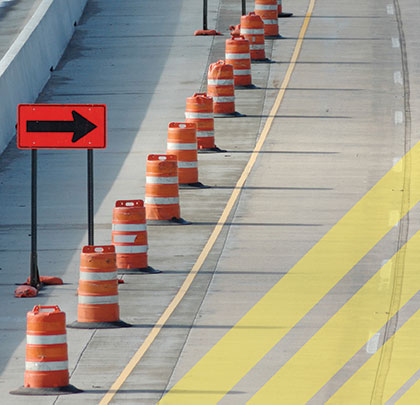Last year, more than 32,000 people lost their lives in motor vehicle accidents. Hundreds of thousands more were involved in accidents. In highway construction work zone areas, thousands of fatalities and injuries are reported on an annual basis. While much of the focus in work zones has been on the loss of life or serious injuries for the workers themselves, a recent study by The Associated General Contractors of America (AGC) shows that the traveling public is also at great risk; nine out of ten work zone accidents involve the traveling public.
With the significant impact of work zone accidents on motorists and passengers, the question arises as to whether State DOTs are doing all they can to save lives and eliminate injuries.
WHERE DO THE FUNDS GO
State DOTs receive billions of dollars in Federal Aid Highway funds and Highway Safety Improvement Project (HSIP) monies. In 2014, the States were apportioned a total of $37.8 billion in Federal Aid Highway funds, plus an additional $2.4 billion in HSIP funds. The top three states to receive such funds were California, Texas, and Florida.
Surprisingly, very little of these HSIP funds have actually been spent on road safety infrastructure and positive protection. State DOTs have largely spent their “safety” HSIP funds on advertising and behavioural safety campaigns to urge motorists to slow down and also to warn of the dangers of distracted driving in work zone areas.
While soft-market advertising campaigns are beneficial for awareness and prevention purposes, they do nothing to block the physical intrusion of vehicles into work zones. Billboard messages do not deflect errant vehicles from crashing through 28-inch orange traffic cones and causing deadly accidents. Lives are being lost and significant and debilitating injuries are occurring. Blaming motorists for their distracted driving does not cure the problem.
For years, both contractors and worker groups have been pushing States and the Federal Highway Administration (FHWA) to provide or reimburse for use of positive protection in work zones. Using HSIP funds for the acquisition of guardrails, barriers, and crash attenuators could significantly diminish the deaths, injuries, and damages. Expending HSIP safety funds on the installation of barriers and crashworthy devices between construction work zones and traffic lanes can save both motorists and workers.
SEPARATION IS KEY
Most work zones are divided into two zones: traffic spaces where motorists are traveling and work spaces where workers are performing their construction, repair, and/or preventive maintenance activities. Keeping the traffic spaces and the work spaces separate is a critical part of ensuring safety in the work zones. One way to accomplish this separation is to use positive protection devices that restrict vehicles from entering the work zone. Many new types of positive protection devices have been introduced in recent years, including portable concrete barriers, movable concrete barriers, movable steel barriers, and highly mobile barriers. Such barriers provide a visual and physical barrier which can help redirect errant vehicles and shield workers from hazards that might arise from motorists leaving the traffic spaces.
FHWA and State DOTs should bear the serious responsibility of providing or reimbursing for use of positive protection in work zones.
In recent years, the FHWA and State DOTs have established memorials and walls of dedication for workers who have lost their lives on the job. Such tragedies should never be forgotten, but they should also compel FHWA and State DOTs to allow contractors and others to use Federal funds on the safety equipment and crashworthy devices that will avoid such tragedies. Such equipment will not only mean avoiding tragedies for workers, but also hundreds of thousands of potentially effected motorists and their families.
CALL TO ACTION
Congress has long been trying to provide direction. For the last 20 years, Congress has been increasingly stressing safety in the transportation reauthorization bills. Congress has apportionment of billions in Federal Aid Highway and HSIP funds. If FHWA and State DOTs are not going to show the leadership for which Congress has repeatedly been calling, perhaps it is time for Congress to statutorily enact the positive protection guidelines. In the last transportation reauthorization bill approved into law more than 2 years ago, Congress instructed FHWA to amend its regulations to require positive separation—positive protection—in various high risk scenarios for the protection of both workers and passing traffic (MAP-21, Section 1405). Those requirements still have not been implemented by FHWA or State DOTs.
While many different strategies and approaches are being used by FHWA and State DOTs to raise awareness and highlight the danger of work zone accidents, it is high time they step up and use the allocated Federal funding and provide meaningful protection for motorists and workers—and not merely blame or “retrain” them. Only then will the investment in safety truly mean safer highways for all. ■
For More Information: What can I do? Ask your Congressmen to statutorily enact the safety amendments of MAP-21 that FHWA has for 2 years failed to adopt. For the phone and email addresses of your Congressmen, visit www.congress.gov/members.
_________________________________________________________________________
Modern Contractor Solutions, June 2015
Did you enjoy this article?
Subscribe to the FREE Digital Edition of Modern Contractor Solutions magazine.



